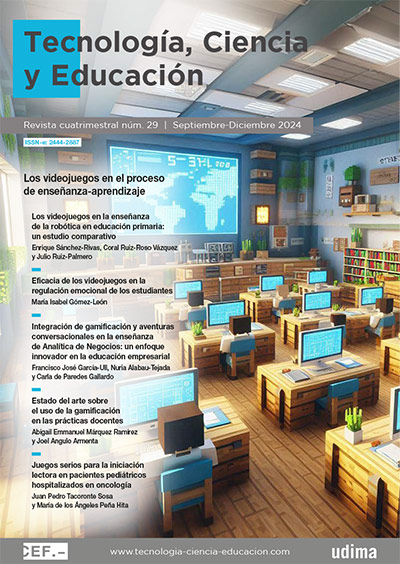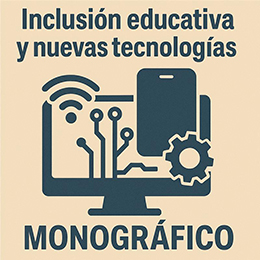La brecha digital en la enseñanza de las ciencias en España durante las leyes educativas LOE y LOMCE
DOI:
https://doi.org/10.51302/tce.2024.20151Palabras clave:
tecnologías de la información y la comunicación (TIC), enseñanza de las ciencias, educación primaria, ordenadores, reformas educativas, LOE (Ley orgánica 2/2006, de 3 de mayo, de educación), LOMCE (Ley orgánica 8/2013, de 9 de diciembre, para la mejora de la calidad educativa), tecnología educacionalResumen
Las últimas dos reformas curriculares en España, la LOE (Ley orgánica 2/2006, de 3 de mayo, de educación) y la LOMCE (Ley orgánica 8/2013, de 9 de diciembre, para la mejora de la calidad educativa), han promovido la integración de las tecnologías de la información y la comunicación (TIC) en la enseñanza de las ciencias de la naturaleza. Sin embargo, el papel de estas reformas en la práctica pedagógica del profesorado (hombres y mujeres) es un aspecto poco investigado. Este estudio examina en qué medida docentes de educación primaria (N = 719) han utilizado las TIC para la enseñanza de las ciencias durante estas leyes educativas y qué papel ha desempeñado en ello el desarrollo profesional continuo. A tal efecto, se realiza un análisis secundario de TIMSS 2011 y TIMSS 2015, cuya recolecta de datos se produjo durante la LOE y la LOMCE respectivamente. Los resultados muestran que i) hubo poca disponibilidad de ordenadores y tabletas digitales para el alumnado; ii) se produjo un uso sumamente escaso de las TIC para la enseñanza de las ciencias, sin una mayor frecuencia durante la LOMCE que en la LOE; iii) el profesorado participó escasamente en cursos de formación profesional continua sobre las TIC; y
iv) el profesorado que sí participó en dichos cursos ha integrado más frecuentemente las TIC en sus clases de ciencias. Estos hallazgos son preocupantes, ya que revelan un modesto impacto de las reformas educativas en las estrategias y recursos didácticos empleados por el profesorado para la enseñanza de las ciencias, lo que redunda en un statu quo de la educación científica española.
Agencias de apoyo
Este estudio de investigación ha sido desarrollado en el marco de un proyecto financiado por la Agencia Estatal de Investigación de España (PID2020-117348RB-I00/AEI/10.13039/501100011033)
Descargas
Citas
Aljuhani, K., Sonbul, M., Althabiti, M. y Meccawy, M. (2018). Creating a virtual science lab (VSL): the adoption of virtual labs in Saudi schools. Smart Learning Environments, 5(16), 1-13. https://doi.org/10.1186/s40561-018-0067-9
Bhargava, P., Antonakakis, J., Cunningham, C. y Zehnder, A. T. (2006). Web-based virtual torsion laboratory. Computer Applications in Engineering Education, 14(1), 1-8. https://doi.org/10.1002/cae.20061
Cañal de León, P., Criado García-Legaz, A. M.ª, García Carmona, A. y Muñoz, G. (2013). La enseñanza relativa al medio en las aulas españolas de educación infantil y primaria: concepciones didácticas y práctica docente. Investigación en la Escuela, 81, 21-42. https://revistascientificas.us.es/index.php/IE/article/view/6895
Cañal de León, P., Criado García-Legaz, A. M.ª, García Carmona, A. y Muñoz Franco, G. (2016). Concepciones didácticas y práctica docente. En P. Cañal de León, G. Travé González, F. J. Pozuelos Estrada, A. M.ª Criado García-Legaz y A. García Carmona (Eds.), La enseñanza sobre el medio natural y social. Investigaciones y experiencias (pp. 177-205). Díada.
Chaljub Hasbún, J., Peguero García, J. R. y Mendoza Torres, E. J. (2022). Aceptación tecnológica del uso de la realidad aumentada por estudiantes del nivel secundario: una mirada a una clase de Química. Tecnología, Ciencia y Educación, 23, 49-68. https://doi.org/10.51302/tce.2022.864
Cohen, L., Manion, L. y Morrison, K. (2018). Research Methods in Education (8.ª ed.). Routledge.
Darrah, M., Humbert, R., Finstein, J., Simon, M. y Hopkins, J. (2014). Are virtual labs as effective as hands-on labs for undergraduate physics? A comparative study at two major universities. Journal of Science Education and Technology, 23(6), 803-814. https://doi.org/10.1007/s10956-014-9513-9
Knapp, H. (2018). Intermediate Statistics Using SPSS. Sage Publications, Inc.
Kolil, V. K. y Achuthan, K. (2023). Longitudinal study of teacher acceptance of mobile virtual labs. Education and Information Technologies, 28, 7.763-7.796. https://doi.org/10.1007/s10639-022-11499-2
Lee, W. C., Neo, W. L., Chen, D.-T. y Lin, T.-B. (2021). Fostering changes in teacher attitudes toward the use of computer simulations: flexibility, pedagogy, usability and needs. Education and Information Technologies, 26, 4.905-4.923. https://doi.org/10.1007/s10639-021-10506-2
Lee, S. W.-Y. y Tsai, C.-C. (2013). Technology-supported learning in secondary and undergraduate biological education: observations from literature review. Journal of Science Education and Technology, 22(2), 226-233. https://doi.org/10.1007/s10956-012-9388-6
LOE. (2006). Ley orgánica 2/2006, de 3 de mayo, de educación (BOE núm. 106, de 4 de mayo de 2006).
LOMCE. (2013). Ley orgánica 8/2013, de 9 de diciembre, para la mejora de la calidad educativa (BOE núm. 295, de 10 de diciembre de 2013).
LOMLOE. (2020). Ley orgánica 3/2020, de 29 de diciembre, por la que se modifica la Ley orgánica 2/2006, de 3 de mayo, de educación (BOE núm. 340, de 30 de diciembre de 2020).
López Simó, V., Couso Lagarón, D., Simarro Rodríguez, C, Garrido Espeja, A., Grimalt Álvaro, C., Hernández Rodríguez, M.ª I. y Pintó Casulleras, R. (2017). El papel de las TIC en la enseñanza de las ciencias en secundaria desde la perspectiva de la práctica científica. X Congreso Enseñanza de las Ciencias (pp. 691-697). Sevilla.
Martin, M. O. y Mullis, I. V. S. (2012). Methods and Procedures in TIMSS and PIRLS 2011. https://timssandpirls.bc.edu/methods/index.html
Martin, M. O., Mullis, I. V. S. y Hooper, M. (2016). Methods and procedures in TIMSS 2015. https://timssandpirls.bc.edu/publications/timss/2015-methods.html
Moreno Martínez, N. M. y Franco-Mariscal, A. J. (2023). Posibilidades didácticas de la herramienta de realidad aumentada ZapWorks en la enseñanza de las ciencias. Una experiencia con estudiantes de un Máster en Profesorado. Tecnología, Ciencia y Educación, 24, 91-118. https://doi.org/10.51302/tce.2023.2808
Reeves, S. M. y Crippen, K. J. (2021). Virtual laboratories in undergraduate science and engineering courses: a systematic review, 2009-2019. Journal of Science Education and Technology, 30(1), 16-30. https://doi.org/10.1007/s10956-020-09866-0
Romero-Ariza, M., Quesada, A., Abril, A. M.ª, Sorensen, P. y Oliver, M. C. (2019). Highly recommended and poorly used: English and Spanish science teachers' view of inquiry-based learning (IBL) and its enactment. EURASIA Journal of Mathematics, Science and Technology Education, 16(1), 1-16. https://doi.org/10.29333/ejmste/109658
Rutten, N., Joolingen, W. R. van y Veen, J. T. van der (2012). The learning effects of computer simulations in science education. Computers & Education Education, 58(1), 136-153. https://doi.org/10.1016/j.compedu.2011.07.017
Scalise, K., Timms, M., Moorjani, A., Clark, L., Holtermann, K. e Irvin, P. S. (2011). Student learning in science simulations: design features that promote learning gains. Journal of Research in Science Teaching, 48(9), 1.050-1.078. https://doi.org/10.1002/tea.20437
Smetana, L. K. y Bell, R. L. (2012). Computer simulations to support science instruction and learning: a critical review of the literature. International Journal of Science Education, 34(9), 1.337-1.370. https://doi.org/10.1080/09500693.2011.605182
Toma, R. B. (2023). Measuring acceptance of block-based coding environments. Technology, Knowledge and Learning, 28, 241-251. https://doi.org/10.1007/s10758-021-09562-x
Webb, M. E. (2005). Affordances of ICT in science learning: implications for an integrated pedagogy. International Journal of Science Education, 27(6), 705-735. https://doi.org/10.1080/09500690500038520
Yazici, S.Ç. y Nakıboğlu, C. (2023). Examining experienced chemistry teachers' perception and usage of virtual labs in chemistry classes: a qualitative study using the technology acceptance model 3. Education and Information Technologies, 1-34. https://doi.org/10.1007/s10639-023-11985-1
Descargas
Publicado
Versiones
- 04-09-2024 (3)
- 01-07-2024 (2)
- 14-06-2024 (1)
Cómo citar
Número
Sección
Licencia
Derechos de autor 2024 Iraya Yánez-Pérez, Radu Bogdan Toma, Jes´us Ángel Meneses-Villagrá

Esta obra está bajo una licencia internacional Creative Commons Atribución-NoComercial-SinDerivadas 4.0.


























